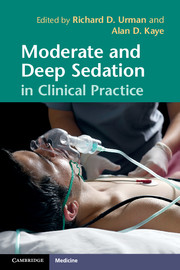
-
Select format
-
- Publisher:
- Cambridge University Press
- Publication date:
- March 2012
- February 2012
- ISBN:
- 9781139084000
- Dimensions:
- Weight & Pages:
- Dimensions:
- Weight & Pages:
You may already have access via personal or institutional login
Book description
Millions of procedures requiring sedation are performed each year; many occur outside of the operating room in both inpatient and outpatient settings. This tremendous growth has resulted in sedation being administered by a wide range of healthcare providers, including non-anesthesiologist physicians, nurses and nurse practitioners. Moderate and Deep Sedation in Clinical Practice is a concise, practical handbook for all medical and surgical professionals who sedate patients. This up-to-date, evidence based, 'how to' manual will: Tell you how to evaluate patients Update you on relevant pharmacologyAdvise you on sedation for specific populations: elderly, pediatric, ICU, emergency room, endoscopy and reproductive technologies Guide you on legal and quality assurance issuesWritten and edited by experts in procedural sedation and sedation education, this book will help users develop safer techniques, policies and procedures. Essential reading for any healthcare provider administering moderate or deep sedation.
Contents
Metrics
Full text views
Full text views help Loading metrics...
Loading metrics...
* Views captured on Cambridge Core between #date#. This data will be updated every 24 hours.
Usage data cannot currently be displayed.
Accessibility standard: Unknown
Why this information is here
This section outlines the accessibility features of this content - including support for screen readers, full keyboard navigation and high-contrast display options. This may not be relevant for you.
Accessibility Information
Accessibility compliance for the PDF of this book is currently unknown and may be updated in the future.


